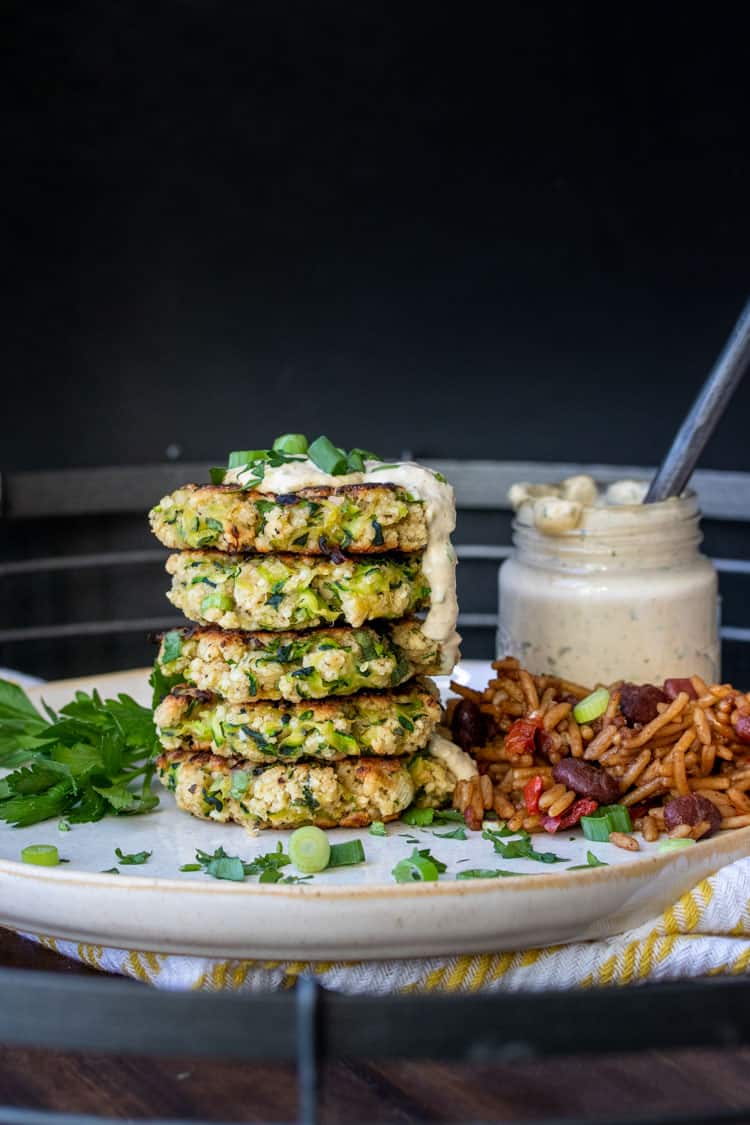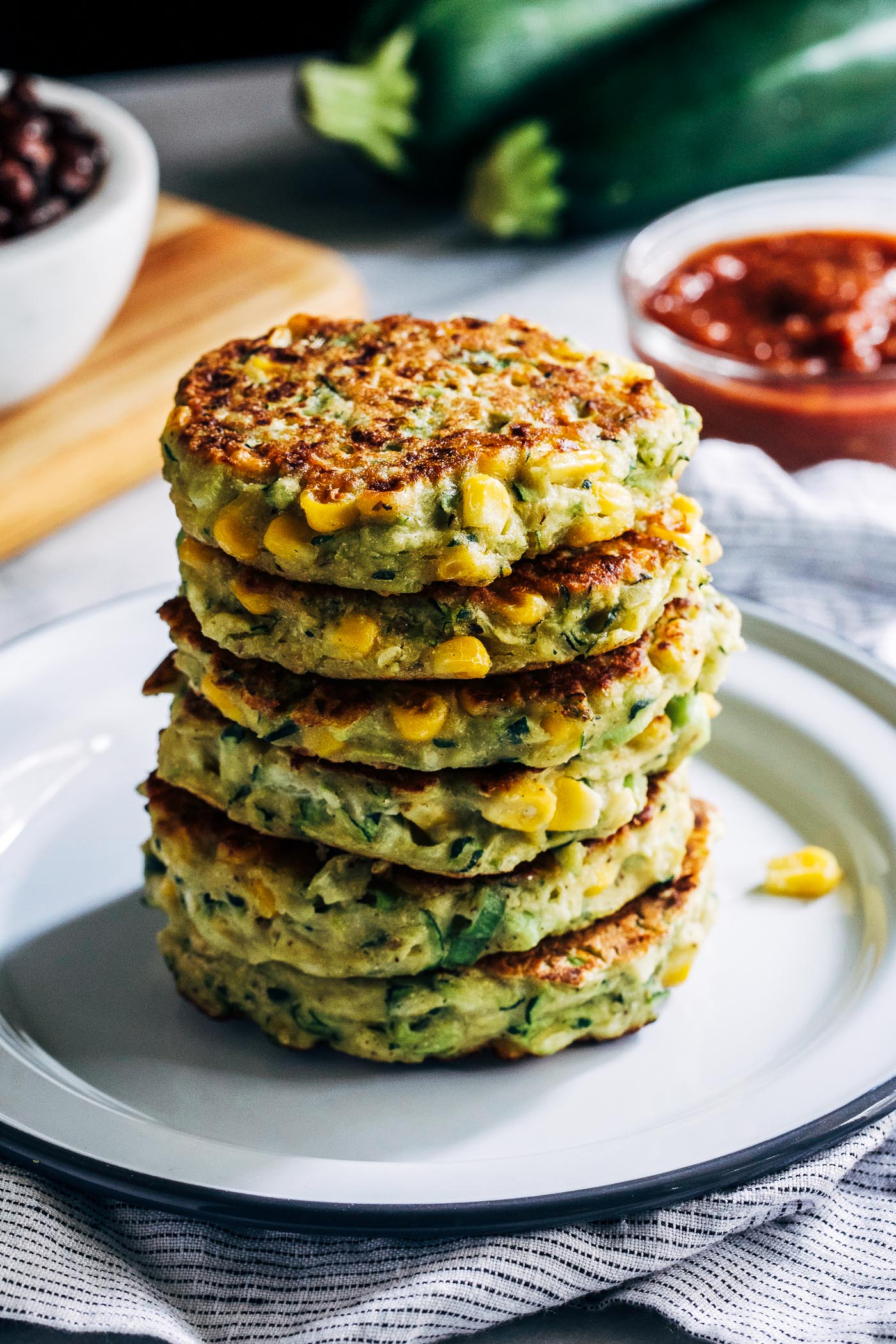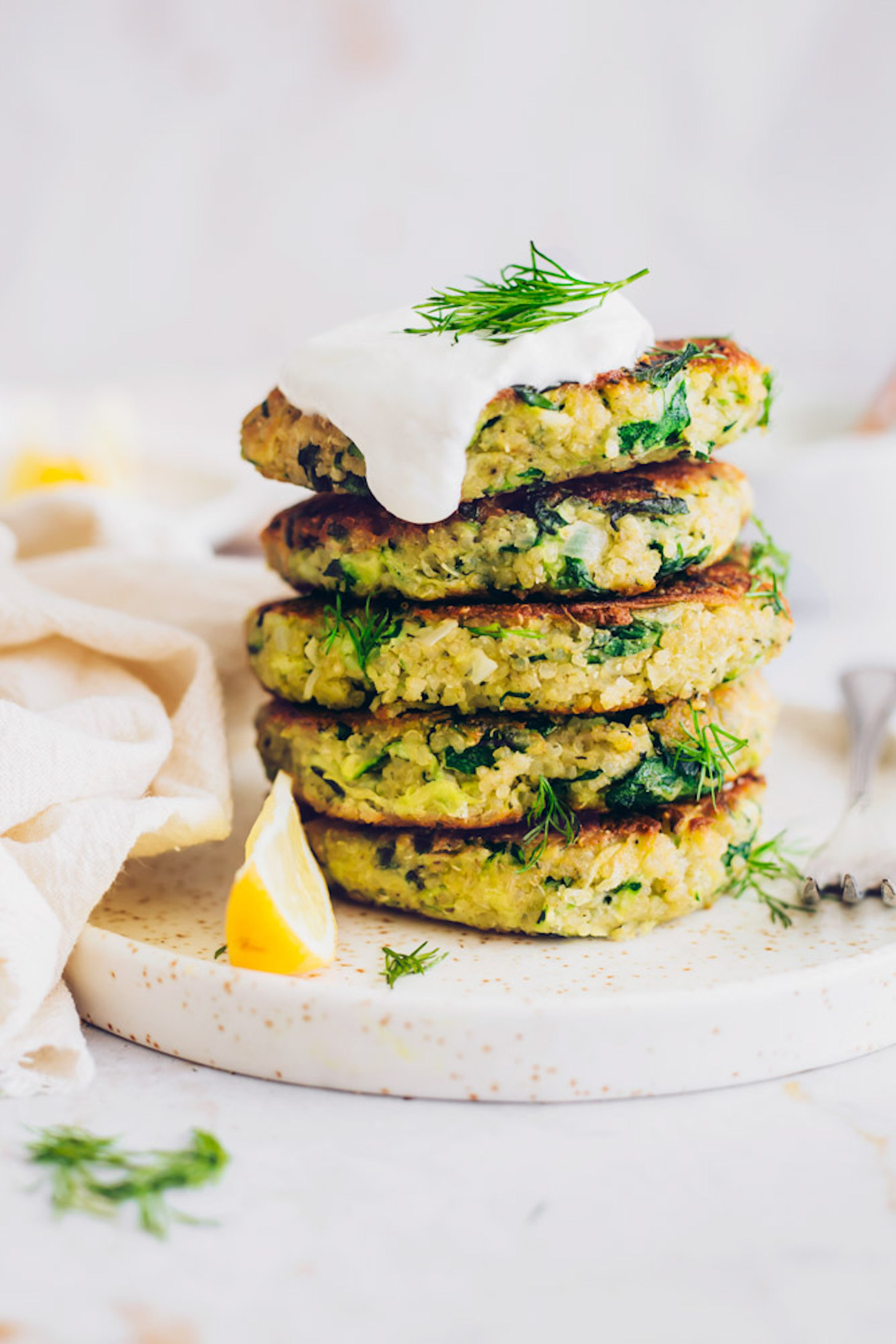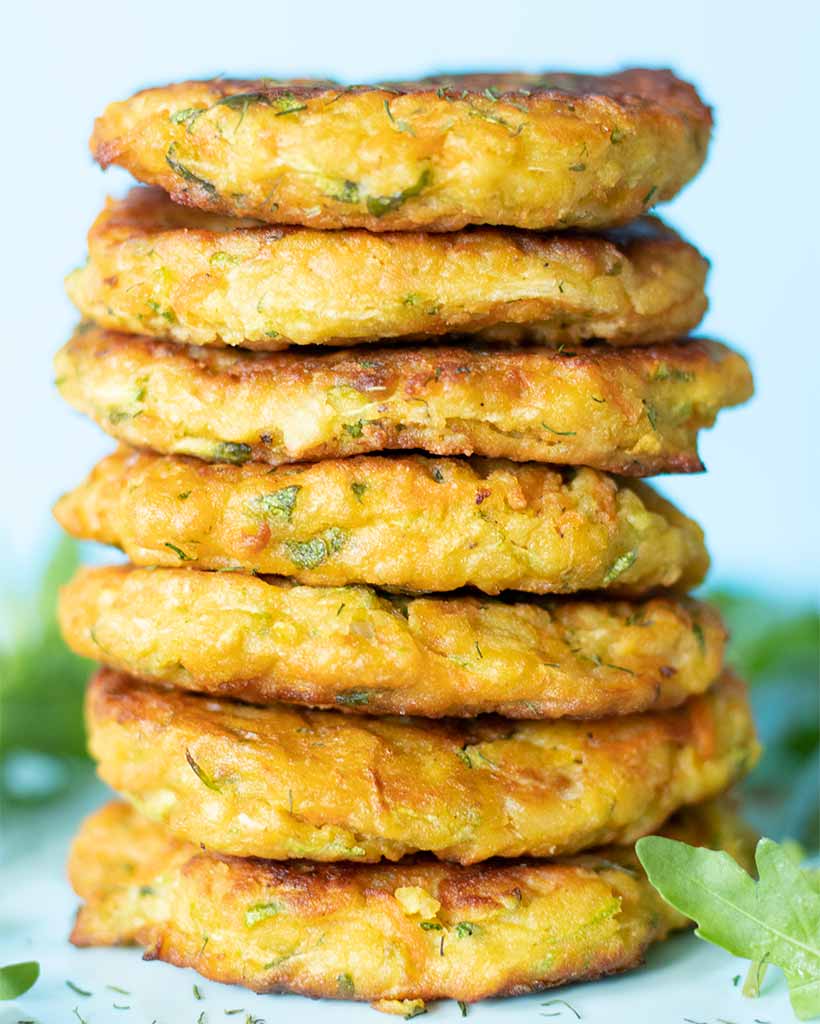Contents
- I. Introduction to Vegan Gluten-Free Zucchini Fritters Recipe
- II. Benefits of Vegan and Gluten-Free Diets
- III. Understanding the Key Ingredients of Zucchini Fritters
- IV. Step-by-Step Guide to Making Vegan Gluten-Free Zucchini Fritters
- V. Tips and Tricks for Perfecting Your Zucchini Fritters
- VI. Frequently Asked Questions about Vegan Gluten-Free Zucchini Fritters:
- 1. Are these zucchini fritters suitable for people with gluten intolerance or celiac disease?
- 2. Can I make these vegan zucchini fritters without eggs?
- 3. How do I achieve a crispy texture in my zucchini fritters?
- 4. Can I freeze these vegan gluten-free zucchini fritters?
- 5. What dipping sauce pairs well with these vegan gluten-free zucchini fritters?
- 6. Can I use yellow squash instead of zucchini?
- 7. Can I make these fritters ahead of time?
- 8. Are these zucchini fritters suitable for children?
- 9. Can I substitute the flours used in this recipe?
- 10. How do I prevent my zucchini fritters from falling apart while cooking?
- 1. Can I use a different type of flour for the recipe?
- 2. How can I make the fritters crispy without deep frying?
- 3. Can I substitute zucchini with another vegetable?
I. Introduction to Vegan Gluten-Free Zucchini Fritters Recipe

Are you looking for a delicious and healthy recipe that caters to your vegan and gluten-free lifestyle? Look no further than these mouthwatering Vegan Gluten-Free Zucchini Fritters! Packed with flavor and nutrient-rich ingredients, this recipe is perfect for those who want to enjoy a tasty dish while adhering to their dietary preferences.
The star ingredient of this recipe is zucchini, which not only adds a delightful freshness but also provides various health benefits. Zucchinis are low in calories and high in fiber, making them an excellent choice for weight management. They are also rich in antioxidants such as vitamin C and manganese, which help boost the immune system.
To make these fritters suitable for vegans, we replace the traditional egg binder with flax eggs. Flax eggs work wonderfully as an egg substitute while adding extra nutritional value with their omega-3 fatty acids content. By using flax eggs, we ensure that our recipe remains vegan-friendly without compromising on taste or texture.
Another essential component of these zucchini fritters is gluten-free flour. We opt for gluten-free alternatives like almond flour or chickpea flour instead of regular wheat-based flour to accommodate individuals with gluten sensitivities or celiac disease. These alternative flours contribute a nutty flavor profile while maintaining the desired consistency of the fritters.
A Flavorful Fusion: Combining Herbs and Spices
To elevate the taste of our zucchini fritters, we incorporate an array of herbs and spices into the batter mixture. Freshly chopped parsley adds a refreshing note, while minced garlic brings depth and complexity to each bite. Additionally, ground cumin lends its warm aroma, complemented by a pinch of smoked paprika that adds a subtle smokiness to the fritters.
Shredded Zucchini: The Secret to Moisture and Texture
Preparing zucchini for these fritters requires shredding them, which not only enhances the overall texture but also helps retain moisture. We recommend using a box grater or a food processor with a grating attachment to achieve uniformly shredded zucchini. By squeezing out excess water from the shredded zucchini, we avoid any potential sogginess in the final product.
A Versatile Delight: Serving Suggestions
Vegan Gluten-Free Zucchini Fritters are incredibly versatile and can be enjoyed in various ways. They make an excellent appetizer when paired with a tangy vegan dipping sauce like tzatziki or spicy sriracha mayo. As a light lunch or dinner option, serve them alongside a vibrant salad filled with fresh greens and colorful vegetables for a complete and satisfying meal.
II. Benefits of Vegan and Gluten-Free Diets

Vegan and gluten-free diets have gained significant popularity in recent years, with many people adopting these dietary choices for various reasons. While they may seem restrictive to some, these diets offer numerous benefits that contribute to overall health and well-being.
1. Improved Digestion
A vegan and gluten-free diet focuses on plant-based foods such as fruits, vegetables, legumes, nuts, and seeds. These foods are rich in fiber which aids digestion by promoting regular bowel movements and preventing constipation. Additionally, eliminating gluten can alleviate symptoms associated with gluten intolerance or sensitivity like bloating, gas, and abdominal discomfort.
2. Increased Energy Levels
The nutrient-dense nature of vegan and gluten-free foods provides the body with essential vitamins, minerals, antioxidants, and phytochemicals necessary for optimal energy production. By consuming a variety of whole plant-based foods without relying on processed options or animal products laden with saturated fats and cholesterol, individuals following these diets often experience increased energy levels throughout the day.
3. Weight Management
A vegan diet inherently promotes weight loss due to its emphasis on whole grains, legumes, fruits, vegetables while minimizing high-calorie animal products like meat or dairy. Furthermore, research has shown that a gluten-free diet can be effective in managing weight by reducing calorie intake from processed wheat-based products often associated with weight gain.
4. Lower Risk of Chronic Diseases
Veganism has been linked to a reduced risk of chronic diseases such as heart disease, diabetes , obesity,and certain types of cancer. Gluten-free diets, on the other hand, benefit individuals with celiac disease or non-celiac gluten sensitivity by preventing long-term complications associated with gluten consumption. By adopting these dietary choices, individuals can significantly lower their risk of developing these health conditions.
5. Enhanced Nutritional Variety
Vegan and gluten-free diets encourage individuals to explore a wider range of foods that they may not have considered before. This promotes nutritional diversity, ensuring that the body receives an array of essential nutrients from different plant-based sources. It also encourages creativity in the kitchen as people discover new ways to prepare and enjoy meals using alternative ingredients.
Overall, choosing a vegan and gluten-free diet offers numerous benefits for both physical health and overall well-being. Improved digestion, increased energy levels, weight management support, reduced risk of chronic diseases, and enhanced nutritional variety are just some of the advantages associated with these dietary choices. By embracing this lifestyle change consciously and responsibly, individuals can experience positive transformations in their lives while contributing to a more sustainable environment.
III. Understanding the Key Ingredients of Zucchini Fritters

When it comes to making delicious vegan gluten-free zucchini fritters, understanding the key ingredients is essential. Each component plays a crucial role in creating a mouthwatering dish that is both healthy and satisfying.
The star of the show: Zucchini
Zucchinis are the main ingredient in these fritters, providing a mild and refreshing flavor. They also add moisture and help bind all the ingredients together. Make sure to choose fresh zucchinis that are firm and vibrant green in color for the best results.
Flour alternatives for gluten-free perfection
To make these fritters suitable for those following a gluten-free diet, traditional wheat flour can be replaced with alternative flours such as almond flour or chickpea flour. These options not only provide structure but also enhance the nutty taste of the dish.
Aromatic herbs and spices
To elevate the flavors of your zucchini fritters, don’t forget to incorporate aromatic herbs and spices. Freshly chopped parsley or dill can add a burst of freshness, while garlic powder or paprika can bring depth and warmth to each bite.
Binder for perfect texture
To ensure that your fritters hold their shape during cooking, you’ll need a binder. Common options include ground flaxseeds mixed with water or aquafaba (the liquid from canned chickpeas). These ingredients act as natural binders without compromising on taste or texture.
Optional additions for extra flair
If you’re looking to add some extra flair to your zucchini fritters, consider incorporating additional ingredients like grated vegan cheese or nutritional yeast for a cheesy flavor. You can also experiment with adding chopped sun-dried tomatoes or olives for a unique twist.
By understanding and utilizing these key ingredients, you’ll be well on your way to creating delectable vegan gluten-free zucchini fritters that will impress even the most discerning taste buds. So, gather your ingredients and let’s get cooking!
IV. Step-by-Step Guide to Making Vegan Gluten-Free Zucchini Fritters

If you’re looking for a delicious and healthy vegan gluten-free recipe, then these zucchini fritters are the perfect choice. Packed with flavor and easy to make, they are a great option for breakfast, brunch, or even as a light lunch. Follow this step-by-step guide to create crispy and savory zucchini fritters that will leave your taste buds wanting more.
Gather Your Ingredients
Before you begin making the zucchini fritters, make sure you have all the necessary ingredients on hand:
- 2 medium-sized zucchinis
- 1 small onion, finely chopped
- 2 cloves of garlic, minced
- 1/4 cup gluten-free flour (such as rice flour or chickpea flour)
- 1/4 cup nutritional yeast flakes (optional)
- 1 teaspoon baking powder
- Salt and pepper to taste
- Olive oil for frying
- Fresh herbs (such as parsley or basil) for garnish (optional)
Squeeze Out Excess Moisture from Zucchinis
The key to achieving crispy fritters is removing excess moisture from the zucchinis. Start by grating the zucchinis using a box grater or food processor. Once grated, place the shredded zucchinis in a clean kitchen towel or cheesecloth and squeeze out as much liquid as possible.
Mix All Ingredients Together
In a large mixing bowl, combine the squeezed grated zucchinis with finely chopped onion, minced garlic, gluten-free flour, nutritional yeast flakes (if using), baking powder, salt, and pepper. Mix everything together until well combined.
Form the Fritters
Heat a generous amount of olive oil in a large skillet over medium-high heat. Take small portions of the zucchini mixture and shape them into patties or fritters. Gently place them in the hot skillet, making sure not to overcrowd the pan.
Cook Until Golden Brown
Cook the fritters for about 2-3 minutes on each side or until they turn golden brown and crispy. You may need to adjust the heat if they are browning too quickly or not cooking through evenly.
Serve and Enjoy!
Once cooked to perfection, transfer the zucchini fritters onto a paper towel-lined plate to absorb any excess oil. Garnish with fresh herbs if desired and serve warm as an appetizer or main dish. These fritters pair well with vegan sour cream or your favorite dipping sauce.
There you have it! A simple step-by-step guide to creating scrumptious vegan gluten-free zucchini fritters that are bursting with flavor. Whether you’re following a specific dietary restriction or simply looking for a tasty way to enjoy zucchinis, this recipe is sure to impress both vegans and non-vegans alike.</p
V. Tips and Tricks for Perfecting Your Zucchini Fritters

When it comes to making the perfect vegan gluten-free zucchini fritters, a few tips and tricks can make all the difference. Whether you’re new to cooking or a seasoned chef, these pointers will help you achieve crispy and flavorful fritters every time.
1. Squeeze Out Excess Moisture
One common challenge when working with zucchini is its high water content. To prevent your fritters from turning soggy, start by squeezing out as much moisture as possible from the grated zucchini. A simple technique involves placing the grated zucchini in a clean kitchen towel or cheesecloth and wringing it tightly until no more liquid is released.
2. Add Binding Ingredients
To ensure that your fritters hold together well during cooking, it’s important to add binding ingredients like flaxseed meal or chickpea flour to your mixture. These ingredients act as natural binders and help give structure to the fritters without relying on eggs or gluten-containing flours.
3. Season Generously
The key to delicious zucchini fritters lies in properly seasoning them. Don’t be shy when adding herbs and spices like garlic powder, onion powder, paprika, or even nutritional yeast for an extra savory flavor boost. Taste-test your mixture before shaping them into patties and adjust the seasonings accordingly.
4. Use High Heat Cooking Oil
To achieve that desirable golden-brown crust on your fritters, choose a high heat cooking oil like avocado oil or grapeseed oil for frying them in a skillet over medium-high heat. These oils have higher smoke points which means they won’t burn easily, allowing you to achieve a crispy exterior without compromising the taste.
5. Maintain Proper Cooking Temperature
When cooking your fritters, it’s crucial to maintain the right temperature. If the heat is too low, your fritters may end up greasy and take longer to cook. On the other hand, if the heat is too high, they might burn on the outside while remaining undercooked inside. Aim for a medium-high heat and adjust accordingly as you go.
6. Allow Fritters to Rest
Once your zucchini fritters are cooked to perfection, resist the temptation to dig in immediately. Allowing them to rest for a few minutes on a wire rack or paper towel will help remove any excess oil and allow them to firm up slightly before serving.
By following these tips and tricks, you’ll be able to master vegan gluten-free zucchini fritters that are packed with flavor and have just the right amount of crispiness. Enjoy them as an appetizer, snack or even as part of a delicious meal!
VI. Frequently Asked Questions about Vegan Gluten-Free Zucchini Fritters:
1. Are these zucchini fritters suitable for people with gluten intolerance or celiac disease?
Yes, these zucchini fritters are completely gluten-free, making them a perfect choice for individuals with gluten intolerance or celiac disease. The recipe uses alternative flours like rice flour or chickpea flour instead of wheat flour.
2. Can I make these vegan zucchini fritters without eggs?
Absolutely! This recipe is entirely plant-based and does not require the use of eggs. Instead, we use ground flaxseed mixed with water as an egg substitute to bind the ingredients together.
3. How do I achieve a crispy texture in my zucchini fritters?
To achieve a crispy exterior, it is crucial to remove excess moisture from the shredded zucchini before incorporating it into the batter. You can do this by salting the shredded zucchini and letting it sit for a few minutes to draw out moisture, then squeezing out any excess liquid using a clean kitchen towel or cheesecloth.
4. Can I freeze these vegan gluten-free zucchini fritters?
Absolutely! These fritters freeze well and can be stored in an airtight container or freezer bag for up to three months. To reheat them, simply place them in a preheated oven at 350°F (175°C) until heated through and crispy again.
5. What dipping sauce pairs well with these vegan gluten-free zucchini fritters?
You have several options when it comes to dipping sauces! A tangy tzatziki made from dairy-free yogurt goes wonderfully with these fritters. Alternatively, you can try a spicy sriracha mayo or a refreshing avocado lime sauce.
6. Can I use yellow squash instead of zucchini?
Absolutely! Yellow squash can be used as a substitute for zucchini in this recipe. It will provide a similar texture and flavor, making it an excellent alternative if you have yellow squash on hand.
7. Can I make these fritters ahead of time?
Yes, you can prepare the batter and cook the fritters ahead of time. Simply store them in the refrigerator and reheat them when ready to serve. However, keep in mind that they are best enjoyed fresh for optimal taste and texture.
8. Are these zucchini fritters suitable for children?
Absolutely! These vegan gluten-free zucchini fritters are kid-friendly and make a great option for introducing vegetables to picky eaters. You can even customize them by adding some grated carrots or corn kernels to make them more appealing to children.
9. Can I substitute the flours used in this recipe?
Absolutely! While we recommend rice flour or chickpea flour for their gluten-free properties, you can experiment with other flours such as almond flour, oat flour, or even all-purpose wheat flour if gluten is not an issue for you.
10. How do I prevent my zucchini fritters from falling apart while cooking?
To prevent your fritters from falling apart, it’s essential to ensure that your batter has enough binding agents like ground flaxseed mixed with water or other egg substitutes mentioned earlier in the recipe instructions. Additionally, avoid overcrowding the pan while frying and flip them gently to prevent breakage.
1. Can I use a different type of flour for the recipe?
When it comes to baking or cooking, experimenting with different types of flours can be a fun and creative way to add unique flavors and textures to your dishes. However, when substituting flours in a recipe, it’s essential to consider the specific characteristics of each type of flour.
If you’re looking to adapt the Vegan Gluten-Free Zucchini Fritters recipe by using an alternative flour, there are several options available that can still yield delicious results.
1. Almond Flour
Almond flour is a popular choice for gluten-free recipes due to its nutty flavor and moist texture. It adds richness and depth to dishes while providing a good source of protein and healthy fats. When using almond flour as a substitute for all-purpose or gluten-free flour in this recipe, keep in mind that it tends to absorb more moisture. You might need to adjust the liquid content accordingly.
2. Chickpea Flour
If you prefer a slightly heartier taste and texture, chickpea flour is an excellent option. Made from ground chickpeas (garbanzo beans), this versatile gluten-free alternative adds a slightly nutty flavor while contributing extra protein and fiber. When using chickpea flour instead of all-purpose or gluten-free flour in this recipe, keep in mind that it has strong binding properties but may require additional liquid as well.
3. Quinoa Flour
If you’re looking for an alternative grain-based option with added nutritional benefits, quinoa flour is worth considering. Quinoa is packed with protein, fiber, vitamins, minerals, and all nine essential amino acids—making it highly nutritious! Substituting quinoa flour for regular or gluten-free flour in this recipe will give your fritters a subtle nutty flavor and a slightly denser texture.
Remember, the texture and taste of your final dish may vary depending on the flour you choose to use. It’s always recommended to start with small substitutions and make adjustments as needed while keeping an eye on the consistency of the batter. Additionally, different flours may require different cooking times or temperatures, so be sure to monitor your fritters closely while they cook.
Ultimately, experimenting with various flours can open up a world of possibilities in vegan and gluten-free cooking. So don’t be afraid to get creative and discover new flavors that suit your preferences!
2. How can I make the fritters crispy without deep frying?
If you’re looking to achieve a crispy texture in your vegan gluten-free zucchini fritters without the need for deep frying, there are a few techniques you can try. While they may not replicate the exact crunchiness of deep-fried fritters, these methods will help you achieve a satisfying crispness while keeping your dish healthier.
1. Bake or air fry
Baking or air frying your zucchini fritters is an excellent alternative to deep frying. Preheat your oven to around 400°F (200°C) and line a baking sheet with parchment paper or greased foil. Place the shaped fritters on the prepared sheet and brush them lightly with oil before baking for about 15-20 minutes, flipping halfway through cooking time. This method will give you slightly softer results compared to deep frying but still offers a delightful crispness.
2. Use enough oil
When pan-frying your fritters, ensure that you use an ample amount of oil in the skillet to promote browning and prevent sticking. Coat the bottom of the pan generously with oil and heat it over medium-high heat before adding the fritter batter.
3. Opt for high-heat oils
To enhance crispiness, choose oils with high smoke points like avocado oil or refined coconut oil instead of using low-smoke-point oils such as olive oil or butter. These high-heat oils tolerate higher temperatures better, resulting in crisper exteriors on your fritters.
4. Drain excess moisture from zucchini
Zucchinis tend to release water when cooked, which can hinder achieving desired crispness in your fritters. To tackle this issue, grate the zucchini and squeeze out as much moisture as possible using a clean kitchen towel or cheesecloth. Removing excess water will help the fritters hold their shape better and crisp up nicely.
5. Add a binding agent
Incorporating a binding agent like chickpea flour or ground flaxseed into your fritter batter can contribute to improved texture and crispiness. These ingredients help hold the fritters together while providing an extra crunch when cooked.
By utilizing these methods, you can create vegan gluten-free zucchini fritters that are crispy and delicious without deep frying. Experiment with different techniques to find your preferred level of crispness while maintaining a healthier cooking style.
3. Can I substitute zucchini with another vegetable?
While zucchini is a versatile and delicious ingredient, there may be times when you want to explore other options or don’t have it on hand. Luckily, there are several vegetables that can be used as substitutes for zucchini in various recipes. Here are a few alternatives worth considering:
1. Yellow Squash
If you’re seeking a similar texture and flavor to zucchini, yellow squash is an excellent substitute. It belongs to the same family of summer squashes and offers a mild taste with a slightly sweeter note. You can use yellow squash in the same quantities as zucchini in your recipe without any major adjustments.
2. Cucumber
Cucumbers can provide a refreshing and crisp alternative to zucchini, particularly in uncooked dishes such as salads or chilled soups. While they may have more water content than zucchinis, cucumbers still offer great texture and add a pleasant crunch to your dish.
3. Eggplant
If you’re looking for something heartier that can withstand cooking methods like grilling or roasting, eggplant is an ideal choice. Although its taste differs from that of zucchini, it offers a meaty texture that works well as a replacement in recipes like fritters or casseroles.
4. Butternut Squash
In certain recipes where the sweetness of butternut squash pairs nicely with other ingredients, it can serve as an interesting substitution for zucchini – especially in baked goods like muffins or breads.
5. Bell Peppers
Bell peppers won’t replicate the exact flavor profile of zucchinis but can still provide a vibrant and colorful addition to your dish. They work well in stir-fries, stuffed peppers, or even as a vessel for fillings typically used with zucchini.
When substituting zucchini with any of these vegetables, keep in mind that cooking times and methods may vary slightly. It’s always a good idea to experiment and adjust the recipe according to your taste preferences.
In summary, if you find yourself without zucchini or want to try something different, there are several options available as substitutes. Yellow squash, cucumber, eggplant, butternut squash, and bell peppers can all bring their unique qualities to your recipes while maintaining the deliciousness factor.

Nicole Allen is a highly skilled and passionate content writer, specializing in SEO. With a strong command of the English language, Nicole has honed her writing skills to deliver engaging and informative content to her readers. Her educational background includes a Bachelor’s degree in English Literature from the University of California, Berkeley. Nicole’s love for veganism and sustainable living has fueled her dedication to creating content that promotes a cruelty-free lifestyle. Her extensive knowledge of plant-based nutrition and ethical consumerism allows her to craft compelling articles that inspire and educate readers on the benefits of embracing a vegan lifestyle.
